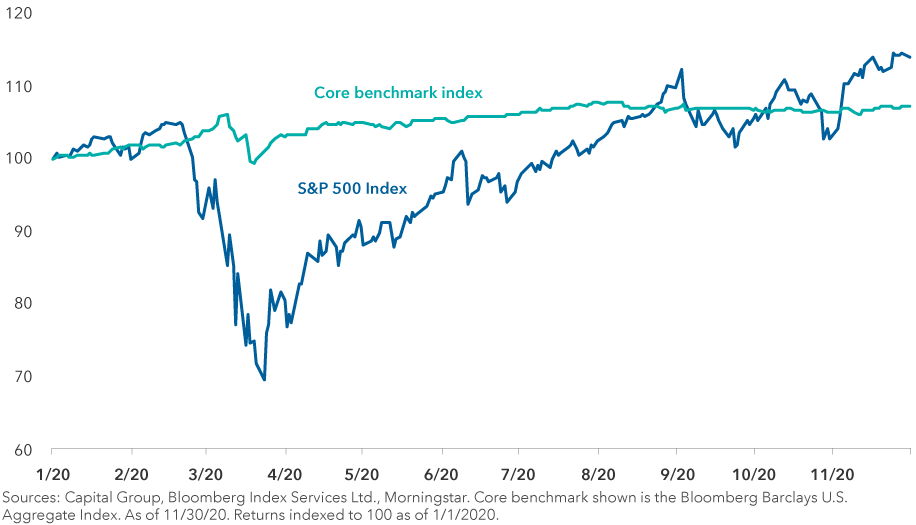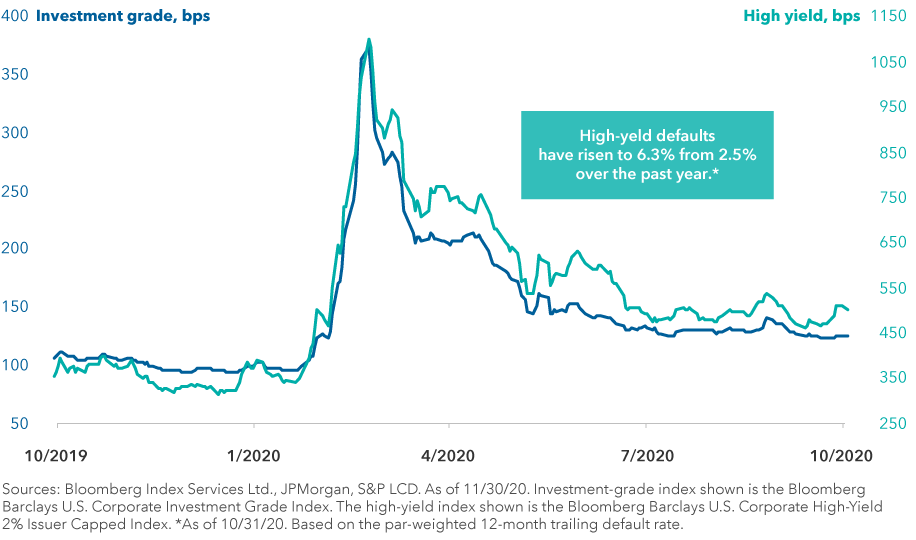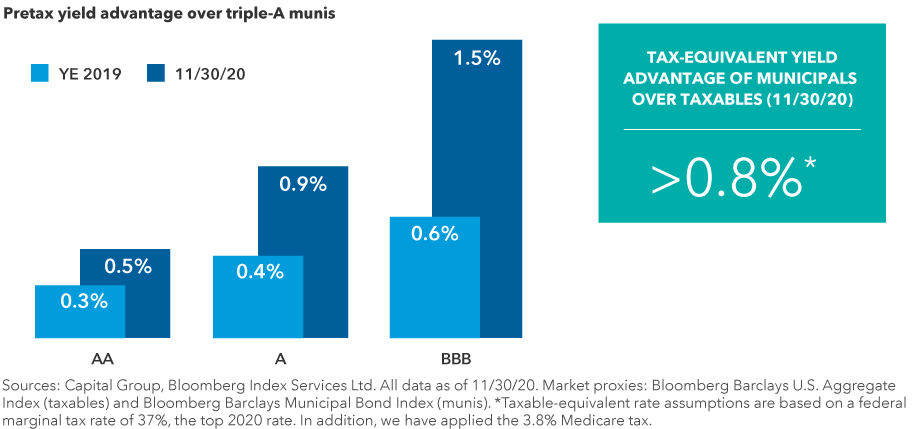Markets & Economy
Bonds
Many people will be happy to forget 2020. In some ways, markets have already moved on, boosted by promising news on vaccines and improving economic data around the world. Investors have found their animal spirits, helping fuel rebounds in prices for equities and other risk assets.
Most fixed income sectors are on track to notch healthy gains for the year. But with low interest rates and relatively modest yields for credit, much of that optimism is already priced into markets. As a result, we expect more moderate returns as we look forward to 2021.
With the tailwind of ultra-low interest rates, accommodative monetary policy and the potential for additional fiscal stimulus, we believe the economy will continue to heal in 2021. And if vaccines and other medical advances prove effective, growth could continue to look better than expected.
However, COVID-19 has had a huge impact on virtually every part of the global economy. These effects will be felt for years to come.
Huge swathes of the small business and services sector have been wiped out and will have to be rebuilt. The future of commercial real estate has been fundamentally changed as businesses have adapted to work-from-home arrangements. Residential real estate is undergoing a massive boom as new home building trends, living preferences and Americans leaving cities have reshaped the industry. Travel, hospitality, energy and retail sectors have all been upended. While this has created opportunities for the strong, it has meant distress or bankruptcy for the weak.
Looking ahead to 2021, we see a vastly different economic and market backdrop compared to the pre-COVID world. Interest rates in many parts of the globe are negative and likely to remain that way for some time.
In the U.S., the Federal Reserve’s near-zero interest rate policy looks set to continue for years while unemployment remains elevated. Inflation had been low and stable for years, but it fell precipitously in 2020. It looks set to push higher going forward due to massive central bank stimulus, stronger economic growth and other factors. After a decade of dollar strength, surging budget deficits and reduced globalization could trigger a U.S. dollar bear market.
The new year is going to look very different. The shifting tides we see ahead create both risk and opportunity for investors. With valuations fully recovered in many parts of the market, active security selection will be critically important. Portfolio managers need to be poised to take advantage of opportunities and avoid investments that will not fully recover.
In this challenging environment, investors should consider these four actions:
1. Do more with cash
In a world where money markets yield almost 0% and inflation is moving higher, holding excess cash is likely to destroy wealth and purchasing power. And with the Fed expected to hold rates down for two years or more, this wealth destruction will be compounded. With an accommodative Fed and an improving economic outlook, excess cash may be a significant drag on returns.
Fixed income offers alternatives that seek to provide relative safety and liquidity, as well as yields that should better keep pace with expected inflation. Short and intermediate taxable funds offer yields near 1%, while short-intermediate muni funds can offer even greater tax-equivalent yields for investors in high tax brackets. And in an actively managed fund, investors may be able to generate even stronger total returns.
Holding cash can be costly
![A bar chart compares yields for money market funds to those from two bond indexes. Prime money market funds, based on the respective Morningstar category, yielded 0.04%. The Bloomberg Barclays U.S. Intermediate Aggregate Bond Index yielded 0.87%. The Bloomberg Barclays Municipal Short Intermediate 1–10 Years Index yielded 0.64%. It also shows the same index yield, on a tax-equivalent basis, of 1.08%. Source: Bloomberg Index Services Ltd. As of November 30, 2020. *Money market fund yield is a seven-day yield as of November 30, 2020. Prime money market funds invest in floating-rate debt and commercial paper of non-Treasury assets, including those issued by corporations. †Taxable-equivalent yield assumptions are based on a federal marginal tax rate of 37%, the top 2020 rate. In addition, we have applied the 3.8% Medicare tax. Yields shown are yield to worst.]](https://static.capitalgroup.com/content/dam/cgc/shared-content/images/charts/chart-short-yields-916x546.png)
While the relative safety of a bond fund is not quite as strong as cash since a negative return is possible, some can get close. Consider a short-term fund consisting of 100% investment-grade bonds and a track record of capital preservation as an alternative to pursue some investment gain.
Two such funds in the taxable and tax-exempt buckets include Intermediate Bond Fund of America® and Limited-Term Tax-Exempt Bond Fund of America®. These funds aim to provide modest income while focusing on capital preservation and diversification from equities. Their three-year correlations to the Standard & Poor’s 500 Composite Index — a good measure of diversification if near zero or below — were –0.08 and 0.27, respectively (F-2 share class as of November 30).

2021 Outlook webinar
Get insights for 2021 and beyond
CE credit available
2. Stay strong at the core
Coming into 2020, some bond bears argued that with most Treasury yields below 2%, fixed income offered little value and might no longer be an effective hedge for a portfolio’s equity investments. Once again, these predictions proved wrong. During the deep equity correction, the Bloomberg Barclays U.S. Aggregate Bond Index, a typical benchmark for core bond funds, did exactly what it was supposed to do. It zigged when stocks zagged, providing both diversification and capital preservation.
Even as equities have recovered, bonds have held up. The benchmark was up 7.4% as of November 2020. In this challenging market environment, high-quality fixed income has shined. Anyone who held a strong core fixed income allocation should be more convinced than ever of its value — and its role in a balanced portfolio.
The core bond benchmark held steady as stocks sank

Equity indexes recently set new all-time highs in the face of a shifting and uncertain economic backdrop. The resulting equity appreciation creates an excellent opportunity for investors to consider rebalancing portfolios by adding fixed income to restore their desired allocation. This would seek to rebuild the diversification and capital preservation that proved so valuable in 2020.
Of course, not all core and core-plus bond funds are created equal. Some put too much emphasis on yield. Such funds take on the sort of credit risk that should be avoided when pursuing stability. A strong track record of diversification from equities matters.
Consider the three-year correlations to the S&P 500 Index of The Bond Fund of America® and American Funds Strategic Bond Fund℠ (our flagship Core and Core-Plus offerings). They were 0.12 and 0.00, respectively (F-2 share class as of November 30), demonstrating strong diversification.
3. Rethink income
Credit is an area where careful security and industry selection should be front and center in 2021. Finding good value in corporate bonds now requires a much more discerning eye. The yield gap between corporate bonds and U.S. Treasuries, known as the spread, has returned to near pre-COVID levels, despite deteriorating prospects and fundamentals.
In other words, corporates on the whole are not offering a tremendous amount of compensation for the additional risks entailed. High-yield default rates have risen and are still rising.
In this type of environment, owning the corporate index indiscriminately at a time when it includes nearly $300 billion of BBB bonds (the lowest investment grade rating) with a negative outlook does not seem prudent. Fundamental research is more important than ever to distinguish between companies with the strongest return potential and those with weakening prospects.
Corporate bond spreads have fallen to near pre-COVID levels

Plenty of opportunities can also provide attractive sources of income beyond investment-grade corporate credit. The coming year is likely to be one where we see significant shifts in sector leadership. A diversified multisector approach can offer particular value here by uncovering additional investment ideas and providing varied sources of potential return.
American Funds Multi-Sector Income Fund℠ takes such an approach. Its managers pursue income by drawing from different sectors — from corporates to securitized bonds to emerging markets debt. This allows managers to pursue the best income opportunities from a broad set of options. By aiming for a 50/50 split of above/below investment grade, managers also remain mindful of risk.
4. Look to municipal bonds for attractive tax-exempt yields
At first glance, the municipal bond market appears to have moved on from its March 2020 meltdown. Strong investor demand has helped fuel a recovery. However, municipal valuations have not rebounded to the same degree as other credit markets, and the impact of the economic downturn will likely cast a long shadow into 2021.
Tax revenue lost during the pandemic leaves some state and local governments with critical budget shortfalls. Likewise, a wide range of muni issuers in sectors such as transportation, higher education, health care and various tax-backed parts of the market have struggled with weaker revenues and higher costs.
We expect to see even greater credit differentiation among muni bonds as fundamentals diverge in the months ahead. Given the likely headwinds, a selective investment approach is crucial. Bottom-up research is an essential aspect of assessing the trade-off between risk and return potential.
This challenging outlook does have a silver lining in today’s low-rate world: improved income potential. Lately, the taxable-equivalent yields offered by municipals have surpassed those of taxable bonds. They are especially attractive for investors in the highest tax brackets.
Some sectors, such as toll roads, have regained much of the ground lost earlier in 2020. However, there are pockets of potential value in other sectors, such as education and health care, across the credit quality spectrum. BBB municipal yields are more than 150 basis points above comparable U.S. Treasuries before the tax exemption — a yield gap well above pre-pandemic levels.
Lower rated investment grade is a sweet spot among munis

Actively managed funds such as The Tax-Exempt Bond Fund of America® have the flexibility to emphasize bonds where research indicates an attractive trade-off between risk and return potential. And don’t forget, this is an asset class that has often provided excellent diversification. As of November 30, 2020, this fund’s F-2 share class had a three-year correlation to the S&P 500 of 0.17%.
Higher yields offered by certain bonds appear to compensate investors for the risks entailed. This is especially true if you factor in the possibility of further federal support for states and local government issuers materializing in 2021. But even without federal aid, some pockets of value in municipals will reward investors over the long term.
Looking ahead, it seems likely that the world will soon start to overcome this terrible pandemic. Even so, it seems prudent to prepare for bumps along the road to recovery. In our view, the four actions outlined can help smooth the ride for your portfolio, no matter what comes next.
The market indexes are unmanaged and, therefore, have no expenses. Investors cannot invest directly in an index.
Investing outside the United States involves risks, such as currency fluctuations, periods of illiquidity and price volatility, as more fully described in the prospectus. These risks may be heightened in connection with investments in developing countries.
The return of principal for bond funds and for funds with significant underlying bond holdings is not guaranteed. Fund shares are subject to the same interest rate, inflation and credit risks associated with the underlying bond holdings. Lower rated bonds are subject to greater fluctuations in value and risk of loss of income and principal than higher rated bonds. Income from municipal bonds may be subject to state or local income taxes and/or the federal alternative minimum tax. Certain other income, as well as capital gain distributions, may be taxable. The use of derivatives involves a variety of risks, which may be different from, or greater than, the risks associated with investing in traditional cash securities, such as stocks and bonds.
Bond ratings, which typically range from AAA/Aaa (highest) to D (lowest), are assigned by credit rating agencies such as Standard & Poor's, Moody's and/or Fitch, as an indication of an issuer's creditworthiness. If agency ratings differ, the security will be considered to have received the lowest of those ratings, consistent with the fund's investment policies. Securities in the Unrated category have not been rated by a rating agency; however, the investment adviser performs its own credit analysis and assigns comparable ratings that are used for compliance with fund investment policies.
Methodology for calculation of tax-equivalent yield:
Based on 2020 federal tax rates. Taxable equivalent rate assumptions are based on a federal marginal tax rate of 37%, the top 2020 rate. In addition, we have applied the 3.8% Medicare tax. Thus taxpayers in the highest tax bracket will face a combined 40.8% marginal tax rate on their investment income. The federal rates do not include an adjustment for the loss of personal exemptions and the phase-out of itemized deductions that are applicable to certain taxable income levels.
Bloomberg Barclays U.S. Aggregate Index represents the U.S. investment-grade fixed-rate bond market. Bloomberg Barclays U.S. Intermediate Aggregate Bond Index is a market index of high-quality, domestic fixed income securities with maturities of less than 10 years. Bloomberg Barclays U.S. Corporate Investment Grade Index represents the universe of investment grade, publicly issued U.S. corporate and specified foreign debentures and secured notes that meet the specified maturity, liquidity, and quality requirements. Bloomberg Barclays U.S. Corporate High Yield 2% Issuer Capped Index covers the universe of fixed-rate, non-investment grade debt. The index limits the maximum exposure of any one issuer to 2%. Bloomberg Barclays Municipal Short-Intermediate 1–10 Years Index is a market value-weighted index that includes investment-grade tax-exempt bonds with maturities of one to 10 years. Bloomberg Barclays Municipal Bond Index is a market value-weighted index designed to represent the long-term investment-grade tax-exempt bond market. Bloomberg® is a trademark of Bloomberg Finance L.P. (collectively with its affiliates, “Bloomberg”). Barclays® is a trademark of Barclays Bank Plc (collectively with its affiliates, “Barclays”), used under license. Neither Bloomberg nor Barclays approves or endorses this material, guarantees the accuracy or completeness of any information herein and, to the maximum extent allowed by law, neither shall have any liability or responsibility for injury or damages arising in connection therewith.
Standard & Poor’s 500 Composite Index is a market capitalization-weighted index based on the results of approximately 500 widely held common stocks. The Standard & Poor’s 500 Composite Index is a product of S&P Dow Jones Indices LLC and/or its affiliates and has been licensed for use by Capital Group. Copyright © 2020 S&P Dow Jones Indices LLC, a division of S&P Global, and/or its affiliates. All rights reserved. Redistribution or reproduction in whole or in part are prohibited without written permission of S&P Dow Jones Indices LLC.
©2020 Morningstar, Inc. All rights reserved. The information contained herein: (1) is proprietary to Morningstar and/or its content providers; (2) may not be copied or distributed; and (3) is not warranted to be accurate, complete or timely. Neither Morningstar nor its content providers are responsible for any damages or losses arising from any use of this information. Past performance is no guarantee of future results.
RELATED INSIGHTS
-
-
Asset Allocation
-
-
Global Equities
-
Economic Indicators
-
Never miss an insight
The Capital Ideas newsletter delivers weekly insights straight to your inbox.
 Mike Gitlin
Mike Gitlin
 Pramod Atluri
Pramod Atluri
 Karl Zeile
Karl Zeile